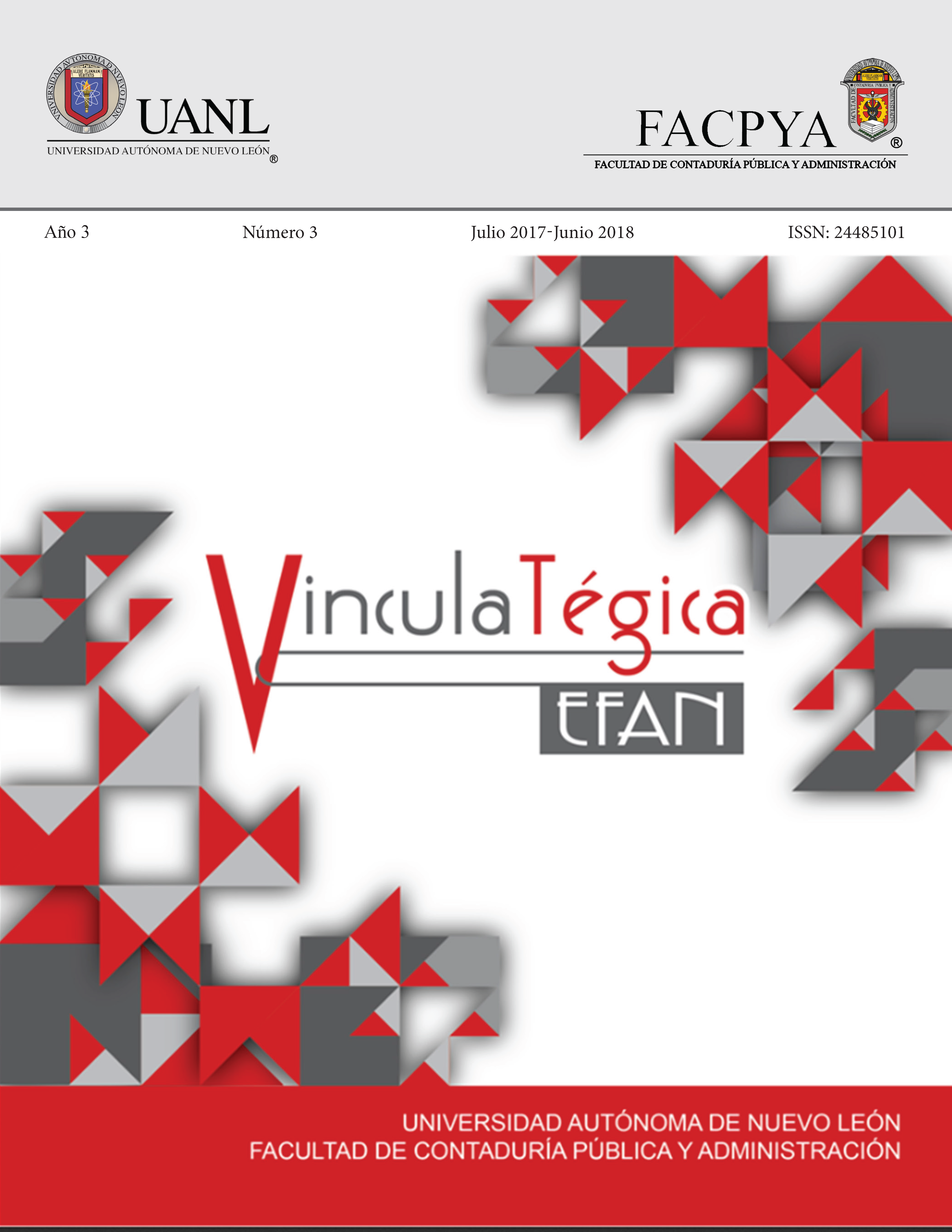Las matemáticas y disciplinas modernas basadas en ellas en la formación de estudiantes de negocios en México, una área de oportunidad.
DOI:
https://doi.org/10.29105/vtga3.3-1082Keywords:
Business education, Operations Research, Data Science, Management ScienceAbstract
The business students are usually related with the social sciences; however, a more competitive world demands professionals with a formation highly oriented towards competitivity and efficiency; and that implies a higher capacity of harnessing numerical and computational methods that quantitatively support the decision-making process. In this paper an area of opportunity for the decision-making process, cornerstone of management, is identified as demanded at international level and an academic proposition is presented to broaden the opportunities of the future professionals of business. The goal of this research is to expose an analysis that raise awareness in those responsible of the education of business students about the validity of the need for those students to be competent in take advantage of numerical and computational methods that sustain and expedite the decision-making process to achieve efficient and well informed decisions.
Downloads
References
Alves, C. A., & Duarte, E. N. (2015). A relação entre a Ciência da Informação e a Ciência da Administração. Transinformação, 27(1), 37–46. http://doi.org/10.1590/0103-37862015000100004 DOI: https://doi.org/10.1590/0103-37862015000100004
Brunner, R. J., & Kim, E. J. (2016). Teaching Data Science. Procedia Computer Science, 80, 1947–1956. http://doi.org/10.1016/j.procs.2016.05.513 DOI: https://doi.org/10.1016/j.procs.2016.05.513
Bulygo, Z. (2013). How Netflix Uses Analytics To Select Movies, Create Content, & Make Multimillion Dollar Decisions. Retrieved May 26, 2017, from https://blog.kissmetrics.com/how-netflix-uses-analytics/
Bussaban, K., & Waraporn, P. (2015). Preparing Undergraduate Students Majoring in Computer Science and Mathematics with Data Science Perspectives and Awareness in the Age of Big Data. Procedia - Social and Behavioral Sciences, 197, 14431446. http://doi.org/10.1016/j.sbspro.2015.07.092 DOI: https://doi.org/10.1016/j.sbspro.2015.07.092
Carbone, A., Jensen, M., & Sato, A.-H. (2016). Challenges in data science: a complex systems perspective. Chaos, Solitons & Fractals, 90, 1–7. http://doi.org/10.1016/j.chaos.2016.04.020 DOI: https://doi.org/10.1016/j.chaos.2016.04.020
Cárdenas-Navia, I., & Fitzgerald, B. K. (2015). The Broad Application of Data Science and Analytics: Essential Tools for the Liberal Arts Graduate. Change: The Magazine of Higher Learning, 47(4), 25–32. http://doi.org/10.1080/00091383.2015.1053754 DOI: https://doi.org/10.1080/00091383.2015.1053754
Cleveland, W. S. (2014). Data science: An action plan for expanding the technical areas of the field of statistics. Statistical Analysis and Data Mining: The ASA Data Science Journal, 7(6), 414–417. http://doi.org/10.1002/sam.11239 DOI: https://doi.org/10.1002/sam.11239
Companys, R., & Ribas, I. (2015). Some Trends and Applications of Operational Research/Management Science to Operations Management. International Journal of Production Management and Engineering, 3(1), 1. http://doi.org/10.4995/ijpme.2015.3459 DOI: https://doi.org/10.4995/ijpme.2015.3459
Conway, D. (2010). The Data Science Venn Diagram — Drew Conway. Retrieved April 21, 2017, from http://drewconway.com/zia/2013/3/26/the-data-science-venn-diagram
Costa, A. M., dos Santos, L. M. R., Alem, D. J., & Santos, R. H. S. (2011). Sustainable vegetable crop supply problem with perishable stocks. Annals of Operations Research, 219(1), 265–265. http://doi.org/10.1007/s10479-010-0830-y DOI: https://doi.org/10.1007/s10479-010-0830-y
Dawid, H., Decker, R., Hermann, T., Jahnke, H., Klat, W., König, R., & Stummer, C. (2017). Management science in the era of smart consumer products: challenges and research perspectives. Central European Journal of Operations Research, 25(1), 203–230. http://doi.org/10.1007/s10100-016-0436-9 DOI: https://doi.org/10.1007/s10100-016-0436-9
Dhar, V. (2013). Data science and prediction. Communications of the ACM, 56(12), 64–73. http://doi.org/10.1145/2500499 Dias, J. (2017). Teaching operations research to undergraduate management students: The role of gamification. The International Journal of Management Education, 15(1), 98–111. http://doi.org/10.1016/j.ijme.2017.01.002 DOI: https://doi.org/10.1016/j.ijme.2017.01.002
Ferguson, A. (2004). A History of Computer Programming Languages. Retrieved April 24, 2017, from http://cs.brown.edu/~adf/programming_languages.html
Fernandes Moreno, C. (2016). Aplicación de técnicas de Big Data Science para la gestión de crisis. Retrieved from http://eprints.ucm.es/40606/
Giabbanelli, P. J., & Mago, V. K. (2016). Teaching Computational Modeling in the Data Science Era. Procedia Computer Science, 80, 1968–1977. http://doi.org/10.1016/j.procs.2016.05.517 DOI: https://doi.org/10.1016/j.procs.2016.05.517
Lakosh, J. (2017). Netflix Earnings: Beyond Subscriber Growth - Netflix, Inc. Retrieved May 24, 2017, from https://seekingalpha.com/article/4063452-netflix-earnings-beyond-subscriber-growth
Larson, D., & Chang, V. (2016). A review and future direction of agile, business intelligence, analytics and data science. International Journal of Information Management, 36(5), 700–710. http://doi.org/10.1016/j.ijinfomgt.2016.04.013 DOI: https://doi.org/10.1016/j.ijinfomgt.2016.04.013
Las mejores Universidades de México | Ranking 2016 | El Economista. (2016). Retrieved April 20, 2017, from http://eleconomista.com.mx/especiales/americaeconomia/2016/10/30/las-mejores-universidades-mexico-ranking-2016
Lopez, F. (2004). Aplicación de un algoritmo genético generacional para un problema de logística de ruteo con entrega y recolección de producto y con ventanas de horario negociable. Universidad Autónoma de Nuevo León.
Matsudaira, K. (2015). The science of managing data science. Communications of the ACM, 58(6), 44–47. http://doi.org/10.1145/2745390 DOI: https://doi.org/10.1145/2745390
Monnapa, A. (2016). Data Science vs. Big Data vs. Data Analytics: Comparison | Simplilearn. Retrieved April 17, 2017, from https://www.simplilearn.com/data-science-vs-big-data-vs-data-analytics-article
Newman, R., Chang, V., Walters, R. J., & Wills, G. B. (2016). Model and experimental development for Business Data Science. International Journal of Information Management, 36(4), 607–617. http://doi.org/10.1016/j.ijinfomgt.2016.04.004 DOI: https://doi.org/10.1016/j.ijinfomgt.2016.04.004
Palocsay, S. W., & Markham, I. S. (2014). Management Science in U.S. AACSB International-Accredited Core Undergraduate Business School Curricula. Journal of Education for Business, 89(2), 110–117. http://doi.org/10.1080/08832323.2013.763755 DOI: https://doi.org/10.1080/08832323.2013.763755
Pérez, G. (2016). Peligros del uso de los big data en la investigación en salud pública y en epidemiología. Gaceta Sanitaria, 30(1), 66–68. http://doi.org/10.1016/j.gaceta.2015.09.007 DOI: https://doi.org/10.1016/j.gaceta.2015.09.007
RAE. (2014). Real Academia Española. Diccionario Usual. Retrieved April 20, 2017, from http://dle.rae.es/srv/search?m=30&w=empírico
Ragsdale, C. T. (2014). Spreadsheet Modeling and Decision Analysis: A Practical Introduction to Business Analytics (7th ed.).
Salazar, B., Balczewski, E., Ung, C., & Zhu, S. (2016). Neuroblastoma, a Paradigm for Big Data Science in Pediatric Oncology. International Journal of Molecular Sciences, 18(1), 37. http://doi.org/10.3390/ijms18010037 DOI: https://doi.org/10.3390/ijms18010037
Staford, B. (1967). Management Science: The Business Use of Operations Research. Aldus.
The OR Society: Society - History of O.R. (n.d.). Retrieved April 21, 2017, from https://www.theorsociety.com/Pages/Society/SocietyHistory.aspx
Wu, D. (2016). Risk management and operations research: a review and introduction to the special volume. Annals of Operations Research, 237(1–2), 1–5. http://doi.org/10.1007/s10479-015-2101-4 DOI: https://doi.org/10.1007/s10479-015-2101-4
Downloads
Published
How to Cite
Issue
Section
License

This work is licensed under a Creative Commons Attribution 4.0 International License.
a). Authors keep copyright and give the journal the right of the first publication of the work under a Creative Commons attribution license. This license allows others to share the work as long as original authorship and initial publication in this journal is acknowledged.
b). Authors may make other independent and additional contractual agreements for the non-exclusive distribution of the version of the article published in this journal (e.g., include it in an institutional repository or publish it in a book) as long as they clearly indicate that the work was published for the first time in this journal.







